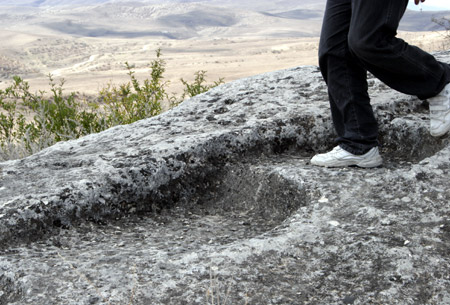
Tigranakert
In the summer of 2006, Armenian media announced to the entire world that the ruins of an ancient city built by King Tigran the Great had been discovered in the Martakert region of Nagorno Karabakh. Archeologist Hamlet Petrosyan said it was no coincidence that that very location had been chosen for excavation - history had pointed to it strongly.
When asked how they identified the probable location of the city of Tigranakert, Petrosyan replied that it had been because of the staircase-like cliffs that stretched across the hill.
“There is a slope or Saralanj above the Shahbulagh spring, which leads to Vankasar, and on that mountain there is a seventh-century church. The cliffs on the section of the slope leading towards Vankasar are dug out. Someone who is not an expert might think that they are a path of some sort, but in reality they form the base for the fortress walls, dug into the cliff.”
He also said that our history had not been made up; all one had to do was carefully read Armenian historical narratives. “We have historical sources and travelers' notes; and after all, that region was called Tkrakert by the Armenians in the nineteenth century.” As Hamlet Petrosyan's sees it, this archeological discovery was one of the few cases when “excavations literally prove historians' claims.”
 |
 |
 |
The first days of the excavation revealed only pottery, which was insufficient evidence to back the claims that this was the city of King Tigran the Great, although they dated back to his time. “We went a little higher and saw that there were two small rocks which seemed to form a line. We decided to dig there and it turned out to be one of the higher areas of the city,” Petrosyan said.
“Ancient architectural techniques assumed that it was the rocks in a wall that determined how strong it would be. The larger the rocks, the smoother and sharper they are, the stronger the wall will be.”
A few days later, another section of the city was discovered. Inscriptions resembling swallowtails were seen on rocks, which testified to advanced architectural skill. This might have seemed trivial, but it led to a very important conclusion.
“This meant that there was a whole team of architects and experts who knew how to polish that stone, process its facets, make a regular pattern and produce ideal smoothness. Managing all that and centering it on the summit of that hill could only be possible if this was a state-sponsored program. That is to say, a local feudal lord could not build a fortress of this kind.”
After discovering the fortress walls, the archeologists assumed that they would find the city on the plain. Here too they found more than they expected.
“It was a sensation, to be honest. We chose an area of five by six. There were walls there, and I assumed that the city church would be there – obviously, not from Tigran the Great's time, but from the Christian era. Because we know about Tigranakert today, one can assume that this city lived a prosperous life after it was founded.”
The excavations were carried out by the Artshakh archaeological group of the Institute of Archaeology and Ethnography of the Academy of Sciences of Armenia with the participation of Hamlet Petrosyan, Zhores Khachatryan, Lyuba Kirakosyan, Hayk Hakobyan and Vardges Safaryan. The Yerkir Union for Repatriation and Resettlement initiated and financed this undertaking.

The excavations lasted only fifteen days, which was not enough to extract this city founded by Tigran the Great from within the depths of history and time. The archeologists have only managed to develop the theory that this is Tigranakert. A lot of time and material resources are required to completely excavate the city. If they are made available, according to Hamlet Petrosyan, it would not only be possible to excavate Tigranakert, but also make other discoveries from the early Christian era in the Khachen River valley.








Tigran Paskevichyan, Anna Sargsyan
 Videos
Videos Photos
Photos
Write a comment